介词inonat在表示时间时的用法区别
- 格式:docx
- 大小:10.85 KB
- 文档页数:6
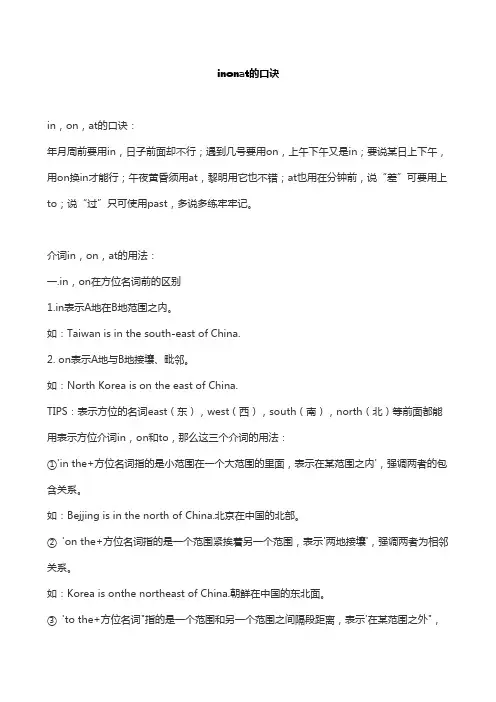
inonat的口诀in,on,at的口诀:年月周前要用in,日子前面却不行;遇到几号要用on,上午下午又是in;要说某日上下午,用on换in才能行;午夜黄昏须用at,黎明用它也不错;at也用在分钟前,说“差”可要用上to;说“过”只可使用past,多说多练牢牢记。
介词in,on,at的用法:一.in,on在方位名词前的区别1.in表示A地在B地范围之内。
如:Taiwan is in the south-east of China.2. on表示A地与B地接壤、毗邻。
如:North Korea is on the east of China.TIPS:表示方位的名词east(东),west(西),south(南),north(北)等前面都能用表示方位介词in,on和to,那么这三个介词的用法:①'in the+方位名词指的是小范围在一个大范围的里面,表示在某范围之内',强调两者的包含关系。
如:Bejjing is in the north of China.北京在中国的北部。
②'on the+方位名词指的是一个范围紧挨着另一个范围,表示'两地接壤',强调两者为相邻关系。
如:Korea is onthe northeast of China.朝鲜在中国的东北面。
③'to the+方位名词"指的是一个范围和另一个范围之间隔段距离,表示'在某范围之外",强调两者是远离关系。
如:Japan is to the east of China.日本位于中国的东边。
二. at,in,on在表示时间上的区别:at表示时间的一点;in表示一个时期;on表示特殊日子。
1. at指时间表示:at后常接几点几分,天明,中午,日出,日落,开始等。
如:at five o' clock(五点),at down(黎明),at daybreak(天亮),at sunrise(日出),at noon(中午),at sunset(日落),at midnight(半夜),at the beginning of the month(月初),at that time(那时),at that moment(那会儿),at this time of day(在一天的这个时候)。
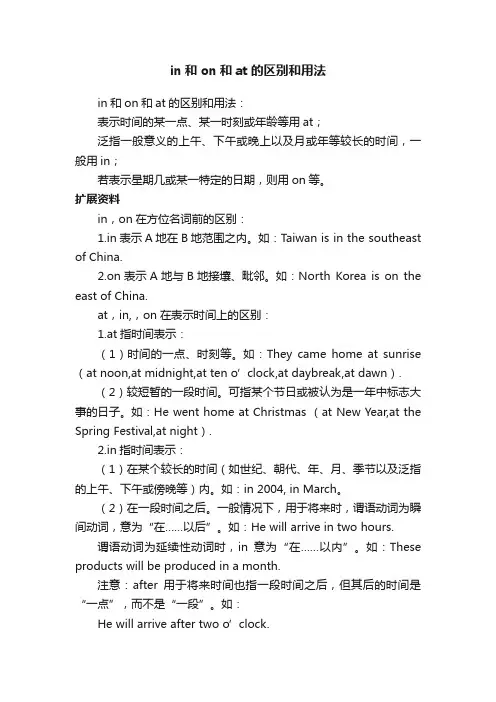
in和on和at的区别和用法in和on和at的区别和用法:表示时间的某一点、某一时刻或年龄等用at;泛指一般意义的上午、下午或晚上以及月或年等较长的时间,一般用in;若表示星期几或某一特定的日期,则用on等。
扩展资料in,on在方位名词前的区别:1.in表示A地在B地范围之内。
如:Taiwan is in the southeast of China.2.on表示A地与B地接壤、毗邻。
如:North Korea is on the east of China.at,in,,on在表示时间上的区别:1.at指时间表示:(1)时间的一点、时刻等。
如:They came home at sunrise (at noon,at midnight,at ten o’clock,at daybreak,at dawn).(2)较短暂的一段时间。
可指某个节日或被认为是一年中标志大事的日子。
如:He went home at Christmas (at New Year,at the Spring Festival,at night).2.in指时间表示:(1)在某个较长的时间(如世纪、朝代、年、月、季节以及泛指的上午、下午或傍晚等)内。
如:in 2004, in March。
(2)在一段时间之后。
一般情况下,用于将来时,谓语动词为瞬间动词,意为“在……以后”。
如:He will arrive in two hours.谓语动词为延续性动词时,in意为“在……以内”。
如:These products will be produced in a month.注意:after用于将来时间也指一段时间之后,但其后的时间是“一点”,而不是“一段”。
如:He will arrive after two o’clock.3.on指时间表示:(1)具体的时日和一个特定的时间,如某日、某节日、星期几等。
如:On Christmas Day(On May 4th),there will be a celebration.(2)在某个特定的早晨、下午或晚上。
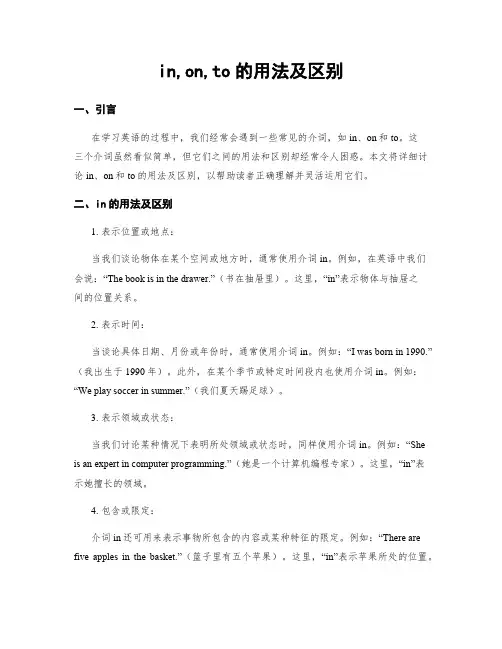
in,on,to的用法及区别一、引言在学习英语的过程中,我们经常会遇到一些常见的介词,如in、on和to。
这三个介词虽然看似简单,但它们之间的用法和区别却经常令人困惑。
本文将详细讨论in、on和to的用法及区别,以帮助读者正确理解并灵活运用它们。
二、in的用法及区别1. 表示位置或地点:当我们谈论物体在某个空间或地方时,通常使用介词in。
例如,在英语中我们会说:“The book is in the drawer.”(书在抽屉里)。
这里,“in”表示物体与抽屉之间的位置关系。
2. 表示时间:当谈论具体日期、月份或年份时,通常使用介词in。
例如:“I was born in 1990.”(我出生于1990年)。
此外,在某个季节或特定时间段内也使用介词in。
例如:“We play soccer in summer.”(我们夏天踢足球)。
3. 表示领域或状态:当我们讨论某种情况下表明所处领域或状态时,同样使用介词in。
例如:“She is an expert in computer programming.”(她是一个计算机编程专家)。
这里,“in”表示她擅长的领域。
4. 包含或限定:介词in还可用来表示事物所包含的内容或某种特征的限定。
例如:“There are five apples in the basket.”(篮子里有五个苹果)。
这里,“in”表示苹果所处的位置。
三、on的用法及区别1. 表示接触或依附:使用介词on可以表示物体与另一个物体之间的接触或依附关系。
例如:“Put the book on the table.”(把书放在桌子上)。
这里,“on”表示书与桌子之间的接触。
2. 表示表面或方位:当我们谈论某物体的表面时,通常使用介词on。
例如:“The sticker is on the wall.”(贴纸在墙上)。
这里,“on”表示贴纸所处的位置。
3. 表示日期和星期:在询问具体日期、星期几时,我们通常使用介词on。
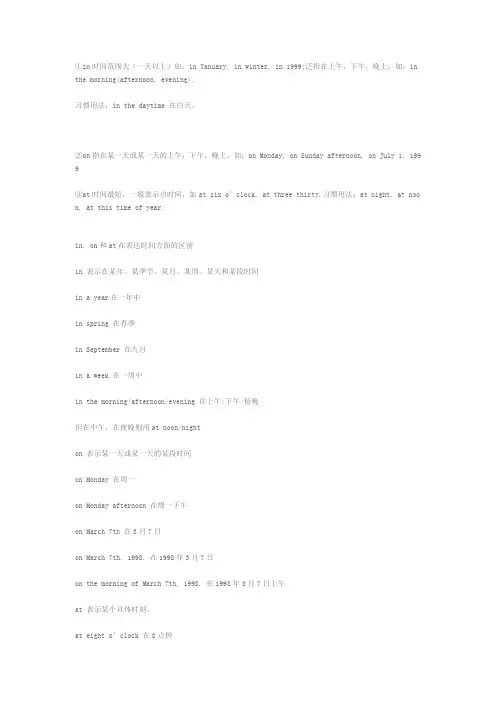
①in时间范围大(一天以上)如:in Tanuary, in winter, in 1999;泛指在上午,下午,晚上,如:in the morning(afternoon, evening).习惯用法:in the daytime 在白天。
②on指在某一天或某一天的上午,下午,晚上,如:on Monday, on Sunday afternoon, on July 1, 1999③at时间最短,一般表示点时间,如at six o’clock, at three thirty.习惯用法:at night, at noo n, at this time of year.in, on和at在表达时间方面的区别in 表示在某年、某季节、某月、某周、某天和某段时间in a year在一年中in spring 在春季in September 在九月in a week 在一周中in the morning/afternoon/evening 在上午/下午/傍晚但在中午,在夜晚则用at noon/nighton 表示某一天或某一天的某段时间on Monday 在周一on Monday afternoon 在周一下午on March 7th 在3月7日on March 7th, 1998. 在1998年3月7日on the morning of March 7th, 1998. 在1998年3月7日上午at 表示某个具体时刻。
at eight o’clock 在8点钟at this time of the year 在一年中的这个时候at the moment 在那一时刻at that time 在那时注意:在英语中,如果时间名词前用this, last, next 等修饰时,像这样的表示,“在某时”的时间短语前,并不需要任何介词。
例如:last month, last week, this year, this week, next year, the next day, the next year等。

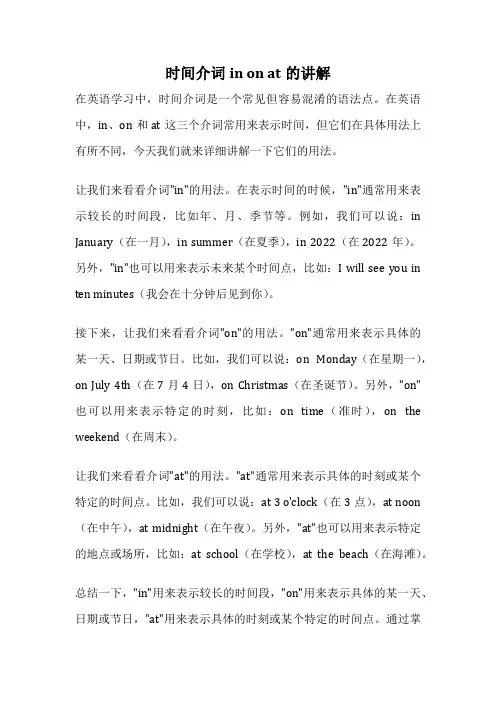
时间介词in on at的讲解在英语学习中,时间介词是一个常见但容易混淆的语法点。
在英语中,in、on和at这三个介词常用来表示时间,但它们在具体用法上有所不同,今天我们就来详细讲解一下它们的用法。
让我们来看看介词"in"的用法。
在表示时间的时候,"in"通常用来表示较长的时间段,比如年、月、季节等。
例如,我们可以说:in January(在一月),in summer(在夏季),in 2022(在2022年)。
另外,"in"也可以用来表示未来某个时间点,比如:I will see you in ten minutes(我会在十分钟后见到你)。
接下来,让我们来看看介词"on"的用法。
"on"通常用来表示具体的某一天、日期或节日。
比如,我们可以说:on Monday(在星期一),on July 4th(在7月4日),on Christmas(在圣诞节)。
另外,"on"也可以用来表示特定的时刻,比如:on time(准时),on the weekend(在周末)。
让我们来看看介词"at"的用法。
"at"通常用来表示具体的时刻或某个特定的时间点。
比如,我们可以说:at 3 o'clock(在3点),at noon (在中午),at midnight(在午夜)。
另外,"at"也可以用来表示特定的地点或场所,比如:at school(在学校),at the beach(在海滩)。
总结一下,"in"用来表示较长的时间段,"on"用来表示具体的某一天、日期或节日,"at"用来表示具体的时刻或某个特定的时间点。
通过掌握这三个介词在表示时间上的用法,我们可以更准确地表达时间概念,避免在表达时间时出现错误。
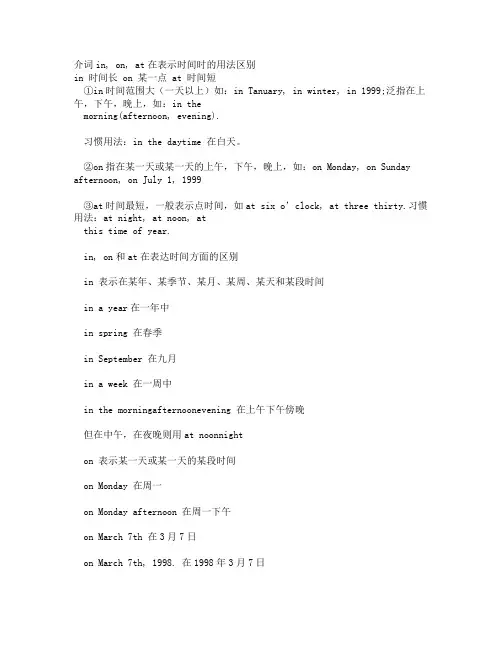
介词in, on, at在表示时间时的用法区别in 时间长 on 某一点 at 时间短①in时间范围大(一天以上)如:in Tanuary, in winter, in 1999;泛指在上午,下午,晚上,如:in themorning(afternoon, evening).习惯用法:in the daytime 在白天。
②on指在某一天或某一天的上午,下午,晚上,如:on Monday, on Sunday afternoon, on July 1, 1999③at时间最短,一般表示点时间,如at six o’clock, at three thirty.习惯用法:at night, at noon, atthis time of year.in, on和at在表达时间方面的区别in 表示在某年、某季节、某月、某周、某天和某段时间in a year在一年中in spring 在春季in September 在九月in a week 在一周中in the morningafternoonevening 在上午下午傍晚但在中午,在夜晚则用at noonnighton 表示某一天或某一天的某段时间on Monday 在周一on Monday afternoon 在周一下午on March 7th 在3月7日on March 7th, 1998. 在1998年3月7日on the morning of March 7th, 1998. 在1998年3月7日上午at 表示某个具体时刻。
at eight o’clock 在8点钟at this time of the year 在一年中的这个时候at the moment 在那一时刻at that time 在那时注意:在英语中,如果时间名词前用this, last, next 等修饰时,像这样的表示,“在某时”的时间短语前,并不需要任何介词。
例如:last month, last week, this year, this week, next year, the next day, thenext year等。
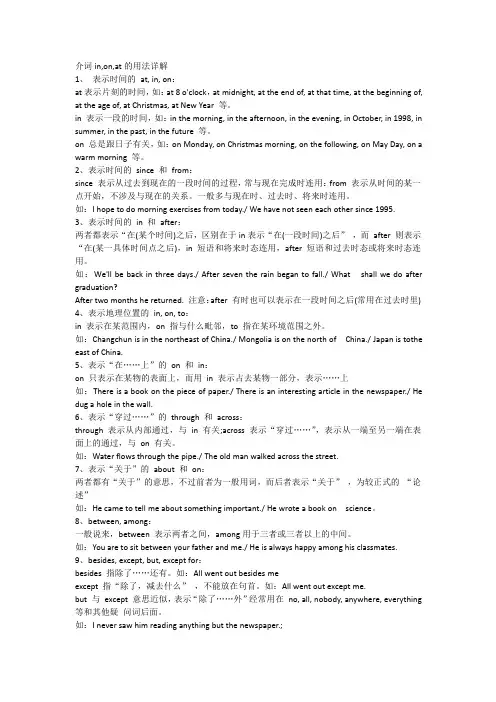
介词in,on,at的用法详解1、表示时间的at,in,on:at表示片刻的时间,如:at8o'clock,at midnight,at the end of,at that time,at the beginning of, at the age of,at Christmas,at New Year等。
in表示一段的时间,如:in the morning,in the afternoon,in the evening,in October,in1998,in summer,in the past,in the future等。
on总是跟日子有关,如:on Monday,on Christmas morning,on the following,on May Day,on a warm morning等。
2、表示时间的since和from:since表示从过去到现在的一段时间的过程,常与现在完成时连用:from表示从时间的某一点开始,不涉及与现在的关系。
一般多与现在时、过去时、将来时连用。
如:I hope to do morning exercises from today./We have not seen each other since1995.3、表示时间的in和after:两者都表示“在(某个时间)之后,区别在于in表示“在(一段时间)之后”,而after则表示“在(某一具体时间点之后),in短语和将来时态连用,after短语和过去时态或将来时态连用。
如:We'll be back in three days./After seven the rain began to fall./What shall we do after graduation?After two months he returned.注意:after有时也可以表示在一段时间之后(常用在过去时里) 4、表示地理位置的in,on,to:in表示在某范围内,on指与什么毗邻,to指在某环境范围之外。

in,on,at的用法与区别in、on、at三者都出现在英语句子中,是用来表示地点关系的。
虽然他们都能表示地点,但却有不小的区别。
首先,in 一般指地点在四周被其他东西包围着,表示在里面的意思;如:He is in the room. 他在房间里。
其次,on 一般指表面或外表,这个地点与其他东西有一定的距离;如:She is on the wall.在墙上。
再次,at指地点的特定位置;如:He is at the door. 他在门口。
同时,在说明时间时,in来表示长一点的时间,on来表示日期,at来表示具体的时刻;如:I will be back in three days.三天后回来。
It’s Tuesday on May 12th. 五月十二号是星期二。
He arrived at 10 o’clock. 他10点钟到达。
此外,有时候我们也可以单独使用in、on、at表示方向;如:Tom is in London.姆在伦敦。
She is on the bus.在公共汽车上。
The crane is at the top of the building.台起重机在建筑物顶端。
为了更好的理解in、on、at用法与区别,让我们来看一看几个例句:1. I was in the garden.2. I was on the wall.3. I was at the gate.4. I will be home in two days.5. I will be home on Monday.6. I will be home at noon.从上面的例句我们可以看出,in示在里面(garden),on示在外表(wall),at示在特定位置(gate);in示未来某个时间(two days),on表示某一天(Monday),at示具体的某个时刻(noon)。
通过上面的分析,我们可以看出在英语句子中in、on、at用法有所不同,我们需要细心掌握他们的用法与区别,才能熟练的使用它们。
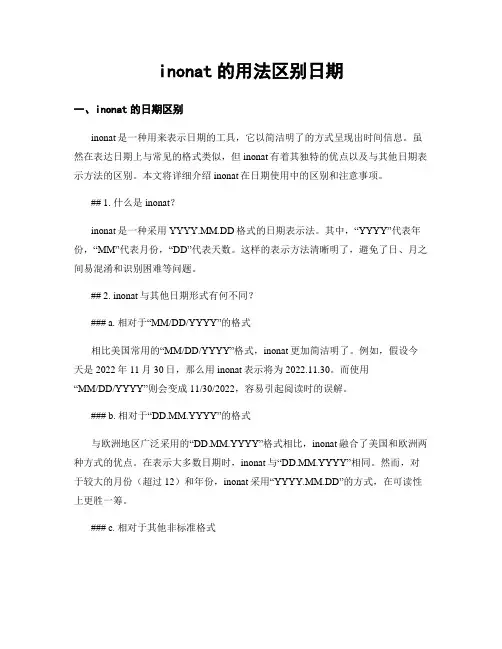
inonat的用法区别日期一、inonat的日期区别inonat是一种用来表示日期的工具,它以简洁明了的方式呈现出时间信息。
虽然在表达日期上与常见的格式类似,但inonat有着其独特的优点以及与其他日期表示方法的区别。
本文将详细介绍inonat在日期使用中的区别和注意事项。
## 1. 什么是inonat?inonat是一种采用YYYY.MM.DD格式的日期表示法。
其中,“YYYY”代表年份,“MM”代表月份,“DD”代表天数。
这样的表示方法清晰明了,避免了日、月之间易混淆和识别困难等问题。
## 2. inonat与其他日期形式有何不同?### a. 相对于“MM/DD/YYYY”的格式相比美国常用的“MM/DD/YYYY”格式,inonat更加简洁明了。
例如,假设今天是2022年11月30日,那么用inonat表示将为2022.11.30。
而使用“MM/DD/YYYY”则会变成11/30/2022,容易引起阅读时的误解。
### b. 相对于“DD.MM.YYYY”的格式与欧洲地区广泛采用的“DD.MM.YYYY”格式相比,inonat融合了美国和欧洲两种方式的优点。
在表示大多数日期时,inonat与“DD.MM.YYYY”相同。
然而,对于较大的月份(超过12)和年份,inonat采用“YYYY.MM.DD”的方式,在可读性上更胜一筹。
### c. 相对于其他非标准格式尽管存在许多非标准化的日期表示方法,inonat作为一种规范化的形式可以在不同场景中保持一致性。
这使得人们在交流、存储和处理时间信息时能够更加便捷和统一。
## 3. inonat使用中需要注意的地方虽然inonat是一种清晰简洁的日期表示方法,但我们还是有必要了解其中一些需要注意的细节。
### a. 零填充问题在inonat中,较小的数字前会加上零以保持位数对齐。
例如,“2022.01.01”代表的是2022年1月1日。
“2022.10.01”则表示2022年10月1日。
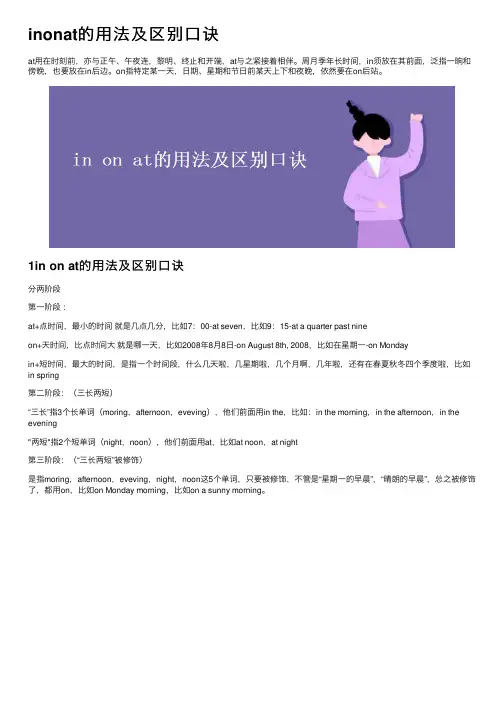
inonat的⽤法及区别⼝诀
at⽤在时刻前,亦与正午、午夜连,黎明、终⽌和开端,at与之紧接着相伴。
周⽉季年长时间,in须放在其前⾯,泛指⼀晌和傍晚,也要放在in后边。
on指特定某⼀天,⽇期、星期和节⽇前某天上下和夜晚,依然要在on后站。
1in on at的⽤法及区别⼝诀
分两阶段
第⼀阶段:
at+点时间,最⼩的时间就是⼏点⼏分,⽐如7:00-at seven,⽐如9:15-at a quarter past nine
on+天时间,⽐点时间⼤就是哪⼀天,⽐如2008年8⽉8⽇-on August 8th, 2008,⽐如在星期⼀-on Monday
in+短时间,最⼤的时间,是指⼀个时间段,什么⼏天啦,⼏星期啦,⼏个⽉啊,⼏年啦,还有在春夏秋冬四个季度啦,⽐如in spring
第⼆阶段:(三长两短)
“三长”指3个长单词(moring,afternoon,eveving),他们前⾯⽤in the,⽐如:in the morning,in the afternoon,in the evening
"两短"指2个短单词(night,noon),他们前⾯⽤at,⽐如at noon,at night
第三阶段:(“三长两短”被修饰)
是指moring,afternoon,eveving,night,noon这5个单词,只要被修饰,不管是“星期⼀的早晨”,“晴朗的早晨”,总之被修饰了,都⽤on,⽐如on Monday morning,⽐如on a sunny morning。
inonat地点的用法区别一、in和on地点表示方式的区别地点词汇在英语中是非常重要的,掌握好它们的用法是建立良好语言表达能力的关键之一。
其中,在表示地点时,人们经常会遇到两个常用的介词,“in”和“on”。
这两个介词虽然有着相似的含义,都可以用来描述事物所在的地方,但实际上它们各自有其独特且有细微差别的用法。
二、介词"in" 的用法1. 描述具体位置当我们想要表达某物位于某个大范围内或封闭空间内时,通常会使用介词"in"。
例如:- The book is in the drawer.(书在抽屉里。
)- She is in her office right now.(她现在在办公室里。
)2. 描述活动场所使用"in"可以表示活动或事件发生的场所。
例如:- They enjoy dining in fancy restaurants.(他们喜欢在高档餐厅就餐。
)- I'm not interested in watching movies in crowded theaters.(我对挤满人的电影院不感兴趣。
)3. 描述家庭住所“in”还可用于描述家庭住所或将某人视为特定集体一员。
例如:- John lives in the United States.(约翰住在美国。
)- My sister is studying in a university.(我妹妹在一所大学里上学。
)4. 描述时间段“in”也可以用于描述特定的时间段或日期。
例如:- We usually have a party in December.(我们通常在十二月举办派对。
)- She was born in 1990.(她出生于1990年。
)三、介词"on" 的用法1. 描述表面位置当我们想要表示某物位于平面或曲面之上时,通常会使用介词“on”。
in,on,at地点和时间用法一、in, on, at的地点用法记住单词的基本含义,通过翻译就很容易区分了。
on强调“在…上”(表面),in强调“在…里”(空间范围内)at强调“点”,可翻译成“在…”“在…处”或者“在...旁”。
以on为例:on表在…上(表面)on the cover of the book. 在书的封面上on this menu. 在这菜单上on the wall. 在那墙上。
(Some pictures are on the wall。
一些图画在墙上。
There are four windows are in the wall. 按照汉语习惯虽然翻译成在墙上有四扇窗,但是实际窗户的位置是在墙“里”。
)on the tree 在树上,指果实长在树上。
(There are some red apples on the tree. 在树上有一些红苹果。
Some birds are in the tree.一些鸟在树上。
指的是树的枝桠间。
)on the 7th floor在八楼(第一层不算。
)也可写成in the 7the storey在八楼on the way to…在去…的路上on the bed 在床上,强调位置,或in the bed,不加冠词时in bed则表示人躺/坐/看书等在床上on the ceiling 在天花板上on the floor 在地板上on the street/road在街道/上(英式写成in the street/road)on the lake 在湖面上,接触湖水表面,比如小船,如吃水深则用in,如A ship is in the river.(over the lake则指在湖的正上方,不接触湖面)on the farm在农场,用on表示开阔处,没有空间in的意思。
on land在陆地上on the top of the mountain在山顶,如顶端是一个点,at the top of the chimney在烟囱顶端on the side of the road在路边上,如lie on the roadside躺在路边。
in on at 的时间用法使用“in on at”的时间用法在英语中,经常使用“in”、“on”和“at”来表示不同的时间概念。
虽然有一些规则可以帮助我们选择正确的用法,但也存在一些例外。
在本篇文章中,我们将逐步回答“in”、“on”和“at”的时间用法,帮助您正确使用这些词。
一、用“in”表示年份、季节和月份我们通常使用“in”来表示年份、季节和月份。
以下是一些建议的用法:- 年份:in 2022(在2022年)- 季节:in spring(在春季)- 月份:in September(在九月)注意:在讨论特定的日期时,我们使用介词“on”。
例如,on January 1st (在1月1日)。
二、用“on”表示星期、日期和特定的日子我们通常使用“on”来表示星期、日期和特定的日子。
以下是一些建议的用法:- 星期:on Monday(在星期一)- 日期:on the 10th(在第10天)- 特定的日子:on Christmas Day(在圣诞节)三、用“at”表示时刻和特定的时间点我们通常使用“at”来表示时刻和特定的时间点。
以下是一些建议的用法:- 时刻:at noon(在中午)- 时间点:at 3 o'clock(在3点钟)现在,我们来看一些例外情况。
首先,我们使用“at”来表示节假日。
例如,在讨论复活节和感恩节等节日时,我们会说“At Easter”(在复活节)或“At Thanksgiving”(在感恩节)。
其次,我们使用“in”来表示一天中的特定时间段。
例如,在说“in the morning”(在早上)或“in the evening”(在晚上)时,我们使用“in”。
最后,我们使用“at”来表示具体的时间点。
例如,在谈论准时或晚到时,我们会说“at 8:00”(在八点)。
同样地,在某个具体时间点的安排或会议时,我们也会使用“at”。
例如,“at the meeting”(在开会的时间)或“at the party”(在聚会的时间)。
最全常用介词用法辨析介词是英语学习的一大难点,也是必考知识点,同学们在学习英语介词的时候很容易将类似的介词使用混淆,今天纳小川总结了常用介词的辨析,有需要的同学们可以收藏哦。
⑴ 时间或地点介词in、on、at、to的用法区别:表示时间时, in表示在一段时间里(在将来时句子中则表示在一段时间之后);on表示在具体的某一天或者某天的上下午等, at表示在某个时刻或者瞬间。
如:He was born on the morning of May 10th.(他出生于五月十日的早晨)I usually get up at 7:00 in the morning.(我通常在早上的七点钟起床)表示地点时, in表示在某个范围之内;on表示在某个平面上或与一个面/地点相接触/相邻;to表示不相邻且不在某个范围内;at则表示在某个具体的场所或地点。
按照地点大小来划分:at<in.如:His glasses are right on his nose.(他的眼镜就架在他的鼻子上) He is at the cinema at the moment.(此刻他正在电影院)Japan is to the east of China.(日本在中国的东方)Chongqing is in the west of China(重庆在中国的西部)Chongqing is on the east of Sichuan(重庆在四川东部)⑵ after与in表示时间的用法区别:“after+(具体时刻/从句)”表示“在…时刻之后”常用于一般时态;“in+(一段时间)”表示“在(多久)之后”,常用于将来时态。
如:He said that he would be here after 6:00.(他说他六点钟之后会来这儿)My father is coming back from England in about a month.(我父亲大约一个月以后从英国回来)⑶ since与for表示时间的用法区别:“since+(具体时刻/that-从句)”表示“自从…起一直到现在”,“for +(一段时间)”表示“总共有…之久”,都常用于完成时态;如:Uncle Li has worked in this factory since 1970.(李叔叔自从1970年起就在这家工厂工作了)Uncle Li has worked in this factory for over 30 years. (李叔叔在这家工厂已经工作了30多年)⑷ by、in与with表示方式的用法区别:都可以表示“工具、手段”,但是by主要表示“乘坐”某个交通工具或“以……方式”,在被动句中可以表示动作的执行者;in表示“使用”某种语言/文字,with表示“使用”某个具体的工具、手段。
介词in, on, at在表示时间时的用法区别in 时间长 on 某一点 at 时间短①in时间范围大(一天以上)如:in Tanuary, in winter, in 1999;泛指在上午,下午,晚上,如:in themorning(afternoon, evening).习惯用法:in the daytime 在白天。
②on指在某一天或某一天的上午,下午,晚上,如:on Monday, on Sunday afternoon, on July 1, 1999③at时间最短,一般表示点时间,如at six o’clock, at three thirty.习惯用法:at night, at noon, atthis time of year.in, on和at在表达时间方面的区别in 表示在某年、某季节、某月、某周、某天和某段时间in a year在一年中in spring 在春季in September 在九月in a week 在一周中in the morningafternoonevening 在上午下午傍晚但在中午,在夜晚则用at noonnighton 表示某一天或某一天的某段时间on Monday 在周一on Monday afternoon 在周一下午on March 7th 在3月7日on March 7th, 1998. 在1998年3月7日on the morning of March 7th, 1998. 在1998年3月7日上午at 表示某个具体时刻。
at eight o’clock 在8点钟at this time of the year 在一年中的这个时候at the moment 在那一时刻at that time 在那时注意:在英语中,如果时间名词前用this, last, next 等修饰时,像这样的表示,“在某时”的时间短语前,并不需要任何介词。
例如:last month, last week, this year, this week, next year, the next day, thenext year等。
1.What’s the weather like in springsummerautumnwinter in your country你们国家春天夏天秋天冬天的天气怎么样?in 在年、月、周较长时间内in a week 在里面in the room用某种语言in English 穿着in redon 某日、某日的上下午on Sunday afternoon 在……上面on the desk 靠吃……为生live on rice 关于 a book on Physics〔误〕 We got to the top of the mountain in daybreak.〔正〕 We got to the top of the mountain at day break.〔析〕 at用于具体时刻之前,如:sunrise, midday, noon, sunset, midnight, night。
〔误〕 Don't sleep at daytime〔正〕 Don't sleep in daytime.〔析〕 in 要用于较长的一段时间之内,如:in the morning afternoon, 或in the week monthyear. 或 in spring supper autumn winter等等。
〔误〕 We visited the old man in Sunday afternoon.〔正〕 We visited the old man on Sunday afternoon.〔析〕 in the morning, in the afternoon 如果在这两个短语中加入任何修饰词其前面的介词都要改为on, 如:on a coldmorning, on the morning of July 14th〔误〕 He became a writter at his twenties〔正〕 He became a writter in his twenties〔析〕这句话应译为:他在20多岁时就成了作家。
在某人的一段生活时间段中要用介词in来表示,而在具体岁数时用at来表示。
〔误〕 He went to New York to find a job in sixteen years old.〔正〕 He went to New York to find a job at sixteen.〔析〕在具体年岁前用at, 如:at the age of 12, at your age,等等。
〔误〕 We went to swim in the river in a very hot day.〔正〕 We went to swim in the river on a very hot day.〔析〕具体某一天要用介词on, 又如:on New Year's Day〔误〕 I'm looking forward to seeing you on Christmas.〔正〕 I'm looking for ward to seeing you at Christmas.〔析〕在节日的当天用on,而全部节日期间用at,Christmas是圣诞节期间,一般要有两周或更长的时间。
〔误〕 I haven't see you during the summer holidays.〔正〕 I haven't seen you since the beginning of the summerholidays.〔析〕 during表示在某一段时间之内,所以一般不与完成时搭配,如:I visited a lot of museums during theholiday. 而for表示一段时间,可以用于完成时,如:I haven't see you for a long time. 而through用来表示时间时则为整整,全部的时间。
如:It rained through thenight.而since则是表达主句动作的起始时间,一般要与完成时连用。
〔误〕 At entering the classroom, I heard the good news.〔正〕 On entering the classroom, I heard the good news.〔析〕 On 加动名词表示一……就。
本句的译文应是:我一进入教室就听见这个好消息了。
又如:on hearing… 一听见, on arrival一到达就……(on表示动作的名词)〔误〕 In the beginning of the book, there are some interesting stories.〔正〕 At the beginning of the book, there are some interesting stories.〔析〕 at the begining与at the end都是指某事物的开始与结束部分,均不指时间范围,而in the beginning则是指开始一段时间。
in the end=at last是指最终,终于之意。
〔误〕 Till the end of next week. I will have finished this work.〔正〕 By the end of next week. I will have finished this work.〔析〕 by 引起的时间状语表示了动作的截止点,其意思为不迟于某一时刻将工作做完,所以主句一般是完成时态。
当然可以有将来时态,如:I'll bethere by fiveo'clock.而till则表达其一动作一直持续到某一时刻,但句中的动词一定要用持续性动词,而瞬间的截止性动词应用其否定句式,如:I won'tfinish this work till(until) next weekend.〔误〕 He came to London before last weekend.〔正〕 He had come to London before last weekend.〔正〕 He came to London two weeks ago.〔析〕 before 一般要与完成时连用,而ago则与一般过去时连用。
〔误〕 I have studied English for three years gince I had come here.〔正〕 I have studied English for three years since I came here.〔析〕 since用来表达主句动作的开始时间,所以其引出的从句中应为过去时,而不能用完成时态〔误〕 I can help you repair this bike. You will get it after two hours.〔正〕 I can help you repair this bike. You will get it in two hours.〔析〕中文经常讲两小时之后来取,两天内会修好,而这个介词在英文中要用in而不要用after。
其原因有二,①after 多用于过去时,如:I arrivedin New York. After three days, I found a job in the bank. ② after加时间是表达一个不确定的时间范围,如:after three days, 即三天之后的哪一天都可以。
所以在许诺若干时间内会完成某事时,一定要用介词in。
〔误〕 Three days after he died.〔正〕 After three days he died.〔正〕 Three days later he died.〔析〕 after 与 later都可以用来表达一段时间之后,但它们所处的位置不同,after 在时间词前,而later在时间词后。
〔误〕 She hid herself after the tree.〔正〕 She hid herself behind the tree.〔析〕 after多用来表达某动作之后,所以有的语法书中称它为动态介词,如:I run after him. After finishing myhomework, I went to see a film. 而behind则多用于静态事物之后。